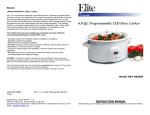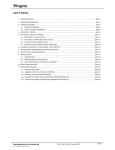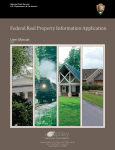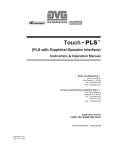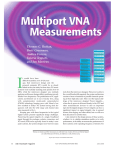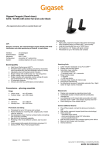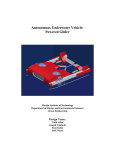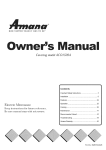Download July - Nebraska Rural Electric Association
Transcript
July 2012 Appliance Innovations Are they really saving you money? Volume 66, Number 7, July 2012 “The Rural Voice of Nebraska” Staff Editor Wayne Price Editorial Assistant Kathy Barkmeier Contents Features Appliance Innovations 6 Published by the Visit us at www.nrea.org General Manager Jay Holmquist President Gary Dill, Roosevelt Public Power District Vice President/Secretary Randy Papenhausen, Cedar-Knox Public Power District Treasurer Ron Jensen, Loup Valleys Rural Public Power District Published monthly by the Nebraska Rural Electric Association, 1244 K Street, Box 82048, Lincoln, Nebraska 68501, (402) 475-4988. Advertising in the Rural Electric Nebraskan does not imply endorsement for products by the Nebraska Rural Electric Association. Correspondence should be sent to Wayne Price, Editor, Rural Electric Nebraskan, Box 82048, Lincoln, NE 68501. The Rural Electric Nebraskan is printed by Jacob North Companies, Box 82046, Lincoln, NE 68501. Form 3579 should be sent to the Rural Electric Nebraskan, Box 82048, Lincoln, NE 68501. Periodicals postage paid at Lincoln, Neb. POSTMASTER: send address changes to the Rural Electric Nebraskan, 1244 K Street, Box 82048, Lincoln, NE 68501. Publication numbers are USPS 071-630 and ISSN 0193-4937. Rates: $10 for one year; $15 for two years; $20 for three years, plus local and state tax. July 2012 When it comes to appliances in the kitchen, they appear to be getting smarter. During the 2012 International Consumer Electronics Show, companies unveiled several appliance twists, including an LCD refrigerator featuring Wi-Fi with a grocery app and a Flex Duo Oven using a Smart Divider to cut wasted cooking space. Cyber Security Patrols 12 Public power districts and electric cooperatives enhance efforts to protect reliability, security of their electric distribution systems. While it’s difficult to thwart a determined computer hacker, with constant vigilance rural electric utilities can significantly minimize the possibilities. Departments EDITOR’S PAGE 4 SAFETY BRIEFS — Murphy 16 CUT YOUR UTILITY BILLS by James Dulley 18 RECIPES 20 ADULT PEN PALS 21 MARKETPLACE/CLASSIFIEDS 22 On the cover Consider both the purchase price and estimated energy use when deciding which brand and model of appliance to buy. See related story on page 6. Photograph provided by GE. 3 EDITOR’S PAGE Are we ready for the electric car? hen I was a boy there were two cars that I wanted to have when I was old enough to drive. They were the Batmobile, from the 1960’s TV show, and the car from the movie Chitty Chitty Bang Bang. I wanted the Batmobile because I think almost every young boy wants some version of the Dark Knight’s gadget filled car. And I wanted the other because it could fly. Over the years the cars I wanted changed to include the 1968 Ford Mustang 390 GT from Bullitt and KITT (Knight Industries Two Thousand), a 1982 Pontiac Trans Am, from the TV Show Knight Rider. These days I just want a car that gets great gas mileage and is safe for me and my family. In the past few years there have been a growing number of reports of electric cars and how they will begin a new era of energy independence. We have already seen a few hybrid cars on the market and last year there was the release of all-electric vehicles by Nissan and Chevrolet. Ford’s first electric car is also one step closer to going on sale. But buying one might require a road trip unless you’re in one of three states. New York, New Jersey and California are the first states where the 2012 Ford Focus Electric is being sold. By the end of the summer it will be available in 19 markets, expanding nationwide by year’s end. According to a Ford press release the car will carry a label approved by the Environmental Protection Agency stating that it gets the equivalent of 110 miles per gallon in city driving and 99 MPGe on the highway. EPA also certified that the Focus Electric can go 76 miles on a charge, though the automaker said that can be extended to 100 miles, depending on driving habits. With a 240-volt outlet, a full charge takes about four hours; at 120 volts it requires 20 hours. These electric vehicles have been hailed as “the future is now” cars. But are they the answer? Will they be the end of the gas combustion engine? Probably not. One of the reasons people purchase hybrids and electric cars is because they want to help save the environment. But will these types of vehicles even do that? Because W by Wayne Price Check us out online 4 you plug them in just like any other appliance — creating more work for power plants — will we really prevent carbon emissions? According to the Electric Power Research Institute, a Palo Alto-Calif., based consortium, the short answer is yes. Despite the increased electric load, various airborne emissions will decline with the onset of electric cars. Each region of the country will see reductions in greenhouse gas emissions over several decades, thanks in part to technologies that decrease carbon dioxide emissions from power plants. In addition, electric cars could actually help electric utilities if consumers plug them in at night — that helps the system run more efficiently because power costs and demand are at their lowest after the sun goes down. Unfortunately, the costs associated with electric cars may still be prohibitive for most Americans. The Cooperative Research Network estimates that payback in terms of gasoline savings would take about a decade (depending on your driving habits). And if you want the car to charge up quickly (instead of the usual four to eight hours or so with a regular 110-V outlet), you’ll have to install a higher-voltage outlet at your home. Besides the cost of having the 220-V outlet installed — which one cooperative wholesale power provider estimates to be about $2,000 — your home’s wiring may need to be updated to accommodate it. The costs add up. The cars themselves aren’t cheap either. The Focus Electric carries a sticker price of $39,200 versus the $16,500 starting suggested retail price for the gasoline-powered Focus. Whether an electric car suits you also depends on your lifestyle, how much you drive, and whether you want your vehicle to have fancy amenities that use more electricity. Cities across the country are attempting to do their part — electric vehicle charging stations are springing up at various locations here and there. But a number of barriers, including cost, limited driving range on a charge, and easy access to chargers, still restrict widespread acceptance. I wonder if we’d be any quicker to embrace a car that flies. Or is loaded with all sorts of crime fighting gadgets. Rural Electric Nebraskan Construction of new Nebraska wind farm currently underway dison Mission Group (EMG), a subsidiary of Edison International, and Nebraska Public Power District (NPPD) announced that construction has started on a new wind project capable of producing enough energy to meet the needs of about 14,000 homes in Nebraska. The Crofton Bluffs project is located in Knox County near the towns of Crofton and Bloomfield in northeast Nebraska. The site is adjacent to another EMG facility near Bloomfield, the Elkhorn Ridge wind project, which was commissioned in 2009. Crofton Bluffs will be powered by 22 wind turbines capable of generating up to 42 megawatts (MW) of electricity. All of the power produced by the project will be sold to NPPD under a 20-year power purchase agreement. Crofton Bluffs is EMG’s fourth wind energy project in Nebraska, all E of which have contracts with NPPD. “Nebraska has emerged as one of the most important states in EMG’s wind energy portfolio, and Nebraska Public Power District has become one of our biggest wind energy customers,” said Pedro Pizarro, president of EMG. “The state offers abundant wind resources and an economic and public policy environment that is supportive and welcoming of clean energy investment. We are pleased to be working again with NPPD to provide environmentally friendly wind power to their customers.” “The addition of Crofton Bluffs moves NPPD another step closer to our board of directors goal of having 10 percent of our energy resources come from renewable energy,” said NPPD President and CEO Pat Pope. “The energy produced will be shared with other Nebraska utilities as we have done at the Ainsworth and other EMG wind farms.” NPPD is currently working with Omaha Public Power District and other Nebraska utilities as partners in the project. Construction of Crofton Bluffs is scheduled to be completed by year end. During construction the project will support about 20 local vendors and contribute about $2.8 million to the state in sales tax revenues. Once completed, Crofton Bluffs will provide about $16 million in property and state tax revenues and lease payments to local landowners over the next 25 years. The wind farm will be managed primarily by existing staff currently operating the adjacent Elkhorn Ridge project, with potential to add four new positions to support operations at Crofton Bluffs. In addition to Crofton Bluffs and Elkhorn Ridge, EMG also operates the Laredo Ridge wind farm near Petersburg in Boone County and is building the Broken Bow wind project in Custer County. Source: Nebraska Public Power District Tri-State issues challenge to EPA regulation in Federal Court ri-State Generation and Transmission Association filed a legal challenge in April to the Environmental Protection Agency’s costly Mercury and Air Toxic Standards (MATS) Rule. The association's lawsuit asks a federal appeals court in Washington D.C. to review the rule, which is not lawful under the Clean Air Act and will significantly increase electricity costs. “The EPA’s MATS rule harms rural electric consumers,” said Ken Anderson, executive vice president and general manager of Tri-State. “The rule was developed in a flawed regulatory process, will impose substantial and unwarranted costs on existing plants, and will effectively prohibit the construction of new coal plants.” Tri-State responsibly generates reliable and affordable electricity for T July 2012 its members and complies with increasingly rigorous state and federal laws. Tri-State’s coal-fired power plants are low emitters of mercury and comply with stringent state mercury limits in Colorado and New Mexico. In fact, Tri-State’s Nucla Station in western Colorado is listed by the EPA in the database to establish the rule as having the lowest mercury emissions of any coal-fired plant in the U.S.; yet the plant will still be burdened with additional regulatory requirements under the rule. “The EPA overstates the benefits of the rule and underestimates the costs,” said Anderson. “The rule is unworkable and has an unrealistic timeframe to implement.” The rule is one of the most expensive regulatory programs in U.S. history. A comprehensive analysis by National Economic Research Associates found that the MATS rule and other finalized and pending EPA regulations for power plants using coal could cost an average of 183,000 jobs every year from 2012-2020 and increase electricity and other energy prices by $170 billion. “This rule, along with other recent EPA regulatory actions, appears geared to taking coal off the table to help meet our nation’s electricity needs,” said Anderson. “We need all options, including coal, to ensure affordable, reliable and responsible power.” Based in the Denver suburb of Westminster, Tri-State supplies power to 18 member public power districts and electric cooperatives in Colorado, 12 in New Mexico, eight in Wyoming and six in Nebraska, which in turn provide electricity to nearly 605,000 meters or a population of approximately 1.5 million people. Source: Tri-State G&T 5 Appliance Inno by Megan McKoy-Noe Rebates and standards transform kitchens and laundry rooms, but are consumers really saving energy? oes your refrigerator have Wi-Fi or a door with a view? Select dishwashers self-dispense detergent and clean based on the number of dishes. And you might be surprised to hear some ovens double as refrigerators. Leave dinner in the oven in the morning, then send a text message for the oven to switch from cooling to cooking mode. D 6 “When it comes to appliances in the kitchen, things are getting smarter,” claims Kevin Dexter, senior vice president of home appliance sales & marketing, Samsung Electronics America. “We’re listening closely to consumers and adding improvements that busy moms want.” During the 2012 International Consumer Electronics Show, Samsung unveiled several appliance twists, including an LCD refrigerator featuring Wi-Fi with a grocery app and a Flex Duo Oven using a Smart Divider to cut wasted cooking space. Samsung isn’t alone. Other manufacturers are also looking for twists to make appliances smarter and keep consumers happy. “At GE Appliances we’re rapidly Rural Electric Nebraskan ovations expanding our Energy Star offerings because it’s what consumers demand and it’s the right thing to do,” explains Rod Barry, director of efficiency and environmental relations. He claims a kitchen equipped with GE’s ecomagination appliances reduces electricity use by 20 percent compared to standard models. But with so many cooks in the kitchen, not all innovations make energy sense. Appliances use 13 percent of a home’s energy — a hefty chunk. Public power districts and electric co-ops are evaluating emerging technologies to find the July 2012 recipe for innovative appliance success. Setting the Standard Manufacturers are constantly enhancing appliances to comply with consumer requests and to meet ever-evolving federal efficiency standards. These standards, first enacted in 1987, drive efficiency innovations and are credited with saving more than $300 billion in electric bills over the past quarter- century, according to the American Council for an Energy Efficient Economy. Current standards set the bar for furnaces, air conditioners, water Please turn to page 8 7 Appliance innovation From page 7 heaters, refrigerators and freezers, washers, dryers, motors, lamps, and other products. In 2011, a U.S. Senate committee considered tightening appliance standards even more, but the bill has not moved forward for a vote. Most manufacturers also strive to meet a higher bar of excellence — the Energy Star certification. Launched by the U.S. Environmental Protection Agency in 1992, Energy Star is a voluntary, international standard for rating energy-efficient consumer products. Not only do qualifying appliances carrying the Energy Star logo meet federal standards, they exceed it. Energy Star-rated appliances use 10 percent to 50 percent less energy and water than standard models. Rebate Revolution After an influx of appliance rebate funds — almost $300 million — from the American Recovery and Reinvestment Act of 2009, many consumers bought efficient appliances in 2010 and 2011. Although rebates were also offered for HVAC systems and water heaters, kitchen and laundry workhorses were the clear Energy-Saving Appliance Tips from Energy Star Clothes Washer • Wash your laundry with cold water whenever possible, using cold water laundry detergents. To save water, try to wash full loads or, if you must wash a partial load, reduce the level of water appropriately. • Water heating accounts for about 90 percent of the energy your machine uses to wash clothes — only 10 percent goes to electricity used by the washer’s motor. • Switching to cold water can save the average household more than $40 annually (with an electric water heater) and more than $30 annually (with a gas water heater). • Washing full loads can save more than 3,400 gallons of water each year. Clothes Dryer • Don’t overdry your clothes. If your dryer has a moisture sensor that automatically turns the machine off when clothes are done, use it. • One of the easiest ways to increase drying efficiency is to clean the lint trap before each and every load. • It’s easy to overdry clothes if one setting is used for various fabrics. Try to dry loads made up of similar fabrics, so the entire load dries as the cycle ends. inside, so run full loads whenever possible. • Select the no-heat drying option. It gives good drying results with less energy. Microwave • Use a microwave or toaster oven to reheat or cook small portions. • Reduce cooking energy by as much as 80 percent when using a microwave for small portions. This also helps save on summer air-conditioning costs, since less heat is generated when compared to using a stove or oven. Oven Range • Use the right sized pot on stove burners. A 6-in. pot on an 8-in. burner wastes more than 40 percent of the burner’s heat. Also, cover pots and pans to keep heat in. • Using the right sized pot on stove burners can save about $36 annually for an electric range, or $18 for gas. Several GE dishwashers Refrigerators feature SmartDispense tech• Keep your refrigerator at 35 to 38 nology. Homeowners can full degrees Fahrenheit. the appliance with up to 47 • Place the fridge in a cool place away fluid ounces of detergent, from a heat source such as an oven, a and the dishwasher releases dishwasher, or direct sunlight. Dishwashers • Rinsing dishes can use up to 20 gal- it as needed. Photograph • Allow air circulation behind the fridge. lons of water before the dishes are provided by GE • Keep the condenser coils clean if it’s loaded. Instead, scrape food off dishes. an older model. Read the user’s manual Energy Star-qualified dishwashers and detergents are to learn how to safely clean coils. Coil cleaning brushdesigned to do the cleaning so you don’t have to. es can be purchased at most hardware stores. • If dirty dishes sit overnight, use the dishwasher’s • Make sure seals around the door are airtight. If rinse feature. It uses a fraction of the water needed to not, replace them. hand rinse. • Minimize the amount of time the refrigerator door • Most dishwashers use about the same amount of stays open. energy and water regardless of the number of dishes Source: Energy Star 8 Rural Electric Nebraskan favorites, garnering 88 percent of all redeemed rebates. About 586,000 consumers added refrigerators, 551,000 added clothes washers, and 297,600 dishwashers were updated. The U.S. Department of Energy (DOE) estimates this influx of efficient appliances will save $48 million in energy costs annually. But these savings are only realized when consumers follow the adage, “Out with the old, in with the new.” Unfortunately, a national electric cooperative survey shows that isn’t always the case. “A lot of folks buy these great new Energy Star refrigerators, then put the old ‘energy hog’ model in the basement as a soda fridge for the kids,” comments Brian Sloboda, a program manager for the Cooperative Research Network (CRN), a division of the National Rural Electric Cooperative Association that monitors, evaluates, and applies technologies to help electric cooperatives control costs, increase productivity, and enhance service to their members. “As a result a lot of potential savings are lost. Sure, it’s convenient to have the extra space, but these folks are paying significantly more just to have cold drinks handy.” CRN partnered with E-Source, a Colorado-based efficiency group, to conduct a national survey of appliances. The study found 19 percent of American homes plug in two refrigerators, and 40 percent of households run a stand-alone freezer, adding expensive cold storage to electric bills. Older models drain energy dollars. A refrigerator from the 1970s costs $200 more to operate every year than a current model; a 1980s fridge isn’t much better, wasting $100 in energy dollars annually. “Even if two models look the same from the outside, less-obvious inside features can mean a big difference in monthly utility bills.” EnergyGuide labels offer energy use and efficiency results from independent laboratory tests; the labels are required for refrigerators, freezers, dishwashers, clothes washers, televisions, water heaters, and select HVAC systems. During the 2012 International Consumer Electronics Show, Samsung unveiled an LCD refrigerator featuring Wi-Fi with a grocery “app.” Photograph provided by Samsung inside — in the motors, compressors, pumps, valves, gaskets and seals, or in electronic sensors that make appliances ‘smarter,’” warns the FTC. Appliance Aid Some states and utilities provide rebates and appliance loan programs. Check dsireusa.org for local incentives, and call your local public power district or electric cooperative to see if appliance aid is available. Some utilities offer rebates for recycling old refrigerators too, helping consumers achieve expected savings. Sources: U.S. Department of Energy, Cooperative Research Network, ESource, Energy Star, Federal Trade Commission, American Council for an Energy Efficient Economy Shop for Savings Consumers should look beyond fancy bells and whistles and research appliances to guarantee energy savings, according to the Federal Trade Commission (FTC). The agency enforces mandatory EnergyGuide labels to help consumers compare brands and shop effectively. “Most of the differences are on the July 2012 9 The Great Outage Detective electric reliability entails using robots to check out the condition of transmission lines. Like DFA, robots seek to prevent outages. But unlike Public power leads the way in introducing outage-pre- DFA, robots directly inspect cables and other components rather than vention technology waveforms. Robots can work on the ground or in the sky, and some even ting-edge algorithms to zero in on operate while suspended from live by Maurice Martin hard-to-find electric system trouble power lines. & Brian Sloboda spots before they morph into fullIt may surprise some folks that blown outages. In its purest form, rural electric utilities have emerged DFA “reads and identifies” specific as leaders in the down-line automafault signatures in a waveform — n keeping with their tradition of tion field. But innovation is a key such as a cracked insulator or a tree innovation, public power dispart our public power DNA. It limb occasionally brushing a line tricts and electric co-ops are embodies the same spirit that drove and causing a blink. Instead of working hard to introduce new techrural residents to find ways to overnologies that will increase come seemingly insurmountservice reliability, decrease able technical, engineering, outage time, and improve legal, political, and financial safety for line crews and the hurdles and bring central public. station electric service to all One of the major areas corners of America. where advancements are takOur not-for-profit, coning place involves down-line sumer-oriented business automation. An umbrella structure ensures all deciterm describing the use of sions technology-based or digital meters and equipotherwise focus on our core ment, software applications, mission: providing members and two-way communicawith a safe, reliable, and tions, down-line automation “Ti,” a 140-lb. robot being developed by the Electric affordable supply of power. allows your rural electric utilIn sprawling, rugged servPower Research Institute, hangs gondola-style from ity to effectively monitor the bulk power lines and rides slowly from tower to tower, ice territories with densities flow of electricity in near realmonitoring the condition of the lines. Robots like Ti sometimes as low as two or time; identify voltages out of seek to prevent power outages. Photograph provid- three consumers per mile, allowed ranges; pinpoint outdown-line automation can ed by Electric Power Research Institute ages; and transmit signals to substantially lower costs by learning about an event, like an outtransformers, capacitors, circuit reducing truck rolls. Following masage, after it happens, public power breakers, and other devices to initisive storms, the ability to target outdistricts and electric co-ops can fix a ate diagnostic or corrective actions age locations from the office and potential problem ahead of time. that can isolate, reroute power efficiently dispatch line crews can An electric cooperative in around, or even remotely repair the significantly speed up getting the Tennessee has been testing a DFA cause of a power interruption. lights back on. system designed by Texas A&M With down-line automation, elecInnovation — it’s proof positive, if University and the Electric Power tric utilities can decrease the numthere was any doubt before, that Research Institute, a Palo Alto, ber of members who lose power and rural electric utilities build a better Calif.-based non-profit consortium the duration of an outage as well as world. whose members include public reduce “line losses” — electricity power districts and electric co-ops. that dissipates in the process of disMaurice Martin and Brian Other electric utilities have signed tributing it over power lines. This Sloboda are senior program up to test DFA’s potential through saves your rural electric utility (and managers specializing in transthe Cooperative Research Network, you) money by not having to buy mission and information techan independent research and develelectricity that doesn’t get used. nology for the Cooperative opment service of the Arlington, Va.One of the most promising Research Network, a service of based National Rural Electric advances in down-line automation, the Arlington, Va.-based Cooperative Association. distribution fault analysis (DFA), National Rural Electric Another down-line tool that could taps high-resolution monitors Cooperative Association. go a long way toward improving installed on electric lines and cut- I 10 Rural Electric Nebraskan Game and Parks urges safety while boating this summer oating is one of America's fastest growing recreational activities. Nebraska alone has in excess of 84,000 power boats. Boaters should not take safety for granted. The Boating Safety Section of the Nebraska Game and Parks Commission suggests ways boaters may reduce the risk of incidents and help ensure a safe and enjoyable day on the water. Wear a Life Jacket – Children under age 13 and anybody on a personal watercraft are required by law to wear a United States Coast Guard-approved personal flotation device. People being towed by a boat on skis, a tube, or other similar device also must wear a life jacket. Avoid alcohol – Boat operators can become impaired with less alcohol than motor vehicle drivers due to heat and dehydration. Boating Under the Influence is a criminal violation and is enforced actively in Nebraska. Have all required safety equipment – This will help boaters be prepared if an emergency occurs. Life jackets, throw cushions, fire extinguishers, and bailing devices are required on most boats. For a list of what is required on a boat, check out the 2012 Boating Guide at BoatSafeNebraska.org. Be wary of surroundings – The best boat operators constantly are looking around for other boats, personal watercraft, swimmers, stumps and other hazards. Speeds in excess of 5 mph are prohibited if within 30 yards of any other vessel, swimming area or dock. Take a boating safety course – Anyone born after Dec. 31, 1985, who operates a motorboat or personal watercraft in Nebraska must have successfully completed the Nebraska boating safety course. Visit BoatSafeNebraska.org for a list of classes. B Cyber Security Patrols Public power districts and electric cooperatives enhance efforts to protect reliability, security of their electric distribution systems by Megan McKoy-Noe Sandia National Laboratories computer scientists Ron Minnich (foreground) and Don Rudish have successfully run more than 1 million Linux kernels as virtual machines, an achievement that will allow cyber security researchers to more effectively observe behavior found in malicious botnets. They used Sandia’s Thunderbird supercomputing cluster for the demonstration. Photograph provided by Sandia National Laboratories our home probably has several security features — door locks, bolts, and an alarm system. When it comes to cyber security, electric cooperatives follow the same principle — building and reinforcing multiple layers of protection to safeguard your personal data from attacks. Securing digital data on an electric distribution system isn’t a “once and done” job. It’s a continual process of evaluating and addressing risks, tightening measures, planning, and evaluating again. While it’s difficult to thwart a determined computer hacker, with con- Y 12 stant vigilance electric cooperatives can significantly minimize the possibilities. “Keeping our members’ information secure is a top priority,” explains Michael Milligan, director of system engineering for Snapping Shoals Electric Membership Corporation in Covington, Ga. “Technology constantly changes, requiring a ‘continuously improving’ approach towards cyber hazards.” Snapping Shoals EMC represents a national trend of cooperatives bulking up cyber security with tools from the Cooperative Research Network (CRN), the research arm of the Arlington, Va.-based National Rural Electric Cooperative Association (NRECA). CRN’s Guide to Developing a Risk Mitigation and Cyber Security Plan and supporting documents, released in 2011 with funding support from the U.S. Department of Energy (DOE), help utilities of all types develop a process to shore up cyber defenses. “Public power districts and electric cooperatives have made substantial progress in cyber security without additional regulation because they owe it to their members to protect system reliability and prevent unauthorized access to Rural Electric Nebraskan personal information,” explains Glenn English, NRECA’s CEO. Security Sweep Rural electric utilities have been working with the DOE, the North American Electric Reliability Corporation (NERC), the Federal Energy Regulatory Commission (FERC), the U.S. Department of Homeland Security, the Obama administration, and the electric utility industry to strengthen and bolster cyber security. An assault on a distribution system, for example, could be a prelude to, or part of, a coordinated cyber strike on the country’s power grid as a whole that could impact electric reliability. Last year, NERC, the nation’s electricity reliability watchdog, conducted an exercise dubbed “GridEx” to identify cyber security concerns and encourage utilities and government agencies to work together to mitigate the issues uncovered. “GridEx provided a realistic environment for organizations to assess their cyber response capabilities,” observes Brian Harrell, NERC manager of Critical Infrastructure Protection standards, training, and awareness. “Through the interaction, participants forged relationships across the cyber security community.” A report on the test notes most utilities have adequate response plans in place, but more training and updated guidelines were suggested. Communication difficulties were also identified — a problem NERC will confront by developing outreach strategies for secure information sharing. To further pinpoint cyber vulnerabilities, a seven-year utility system security study was conducted by the DOE’s Idaho National Laboratory (INL). Poor “patch management” was cited as the biggest utility weakness — patches fix publicly known security problems. To prevent would-be hackers from discovering security lapses, teams of grid guardians routinely scour electric distribution systems to find and fix weak spots. “I look for vulnerabilities in control July 2012 system software,” remarks May Chaffin, an INL cyber security researcher. “I try to get them repaired before someone takes advantage.” Lessons learned from the GridEx activity and researchers like Chaffin have been incorporated into CRN’s cyber security toolkit. Based on best practices developed by the National Institute of Standards and Technology (NIST) and other industry organizations, the guide focuses on procedures electric utilities should adopt to continuously monitor cyber threats and enhance risk preparedness. Two INL cyber security specialists conduct research on an electric utility Supervisory Control and Data Acquisition system. Photography provided by Idaho National Laboratories “CRN’s cyber security resources are well-rounded tools that helped make our existing security plan more complete and serve as references for future projects,” Milligan comments. Andy Bochman, an energy security lead for IBM’s rational division, praises CRN’s efforts. “While the [IT] community is waiting for [practical] implementation guides from NIST, CRN’s offering breaks things down into actionable, prioritized parts. It allows co-ops to travel down a wellmarked path toward better cyber security and risk mitigation plan- ning in the age of the smart grid.” Regulating Security The possibility of cyber mischief undermining automated digital technologies used by utilities has Congress, the White House, and regulators considering the right balance of security and emergency response initiatives. “There is no question that there will be some kind of legislation,” predicts English. “It’s important that policymakers make a distinction between what’s appropriate security for bulk power versus distribution systems. The question is whether what’s put forward makes sense, if it will be overly burdensome, and if it will make electricity less affordable for our members.” In 2010, the U.S. House considered the Grid Reliability and Infrastructure Defense Act. A similar measure, the Cyber Security Act of 2012, was introduced to the U.S. Senate in February. Both bills would provide the federal government with more power to draft cyber security standards but would weaken the NERC/FERC partnership that allows industry stakeholders to help ensure standards are technically sound and able to be properly implemented. NRECA cyber security experts believe any legislation should focus on encouraging federal agencies to routinely provide actionable, timely intelligence about cyber threats and vulnerabilities to utility industry experts. “Hackers are getting smarter, and for some, much of the fun is the challenge of beating your system,” observes CRN Program Manager Maurice Martin. “Rural electric utilities understand cyber security isn’t a one-time thing. Improved communications about potential trouble remains key to this effort.” Electric utilities are building cyber barricades and fashioning robust plans for addressing current and future dangers. But in a rapidly evolving cyber environment, there’s no such thing as perfect security. Sources: Idaho National Laboratory, CRN, NRECA, NERC 13 Biomass expansion would revolutionize world politics eplacing foreign oil with domestically grown biomass would revolutionize world politics and economies, with states such as Nebraska emerging as potentially huge winners, says a former Clay County farm boy who's now one of the world's leading biotechnology scientists. Jay Keasling, a professor of biochemical engineering at the University of California, Berkeley, spoke Tuesday, May 8, 2012 on "The Bold Future of Alternative Energy," as the final guest in the 2011-12 Heuermann Lectures at the University of Nebraska-Lincoln. Using 2009 statistics, Keasling said that of the 94.5 quadrillion BTUs of energy used in the United States, 83 percent came from fossil fuels. The U.S. now imports about half that oil, and those oil imports account for roughly half of the nation's trade imbalance. And, of course, fossil fuels emit high levels of carbon dioxide into the atmosphere. Future oil shortages are predicted as China and India increase use at a time when oil production is leveling off and dropping. Prices could reach $200 a barrel, doubling the price of gasoline. Ethanol from corn already is making inroads into that dependence on foreign oil, but that's only part of the answer, Keasling said. Indeed, corn is far from the ideal biofuels crop, since it requires lots of water and fertilizer and also is important as a food and feed crop. So, other forms of biomass are in development, including switchgrass, which can produce four times the amount of energy it takes to grow it, Keasling noted. Keasling's research team at a firm he founded, the Joint BioEnergy Institute, is heavily involved in those efforts. Scientists there engineered a strain of Escherichia coli bacteria to produce biodiesel fuel from biomass such as switchgrass, R 14 without the need of enzyme additives. His team now is working to increase the efficiency and speed by which its engineered E. coli strain can be cost-effective and economically competitive in quantities needed to meet the world need. "We need to rely on dedicated energy crops" such as switchgrass, said Keasling, who received his bachelor's degree from UNL. "This would be a huge change in our balance of trade, a huge change in world politics," he added, noting that the money now going overseas to purchase oil could be going into economies of farm states such as Nebraska. Miscanthus giganteus is a particularly promising biomass crop. It's a perennial that grows 12 feet tall; it also fixes nitrogen in the soil. "It looks to be a great crop for the future," Keasling said. Scientists like Keasling are focusing on making more efficient the process for getting energy out of biomass crops. Sugars – which comprise about 70 percent of plants' content – are the key, but extracting them and processing them is tricky. Goals are to develop plants that con- tain more of the so-called "good sugars," less of the bad, and fewer lignins, which are organic polymers in plant cell walls that make them rigid and woody. Research efforts are focused on improving pretreatment processes to remove lignins and engineering plants to have less lignin. "This is a very exciting area of research," he added. While bioenergy has successfully produced gasoline substitutes, future research also must produce diesel and jet fuel substitutes. Keasling said he also expects biomass production to result in chemicals from those plant sugars to replace other substances that now come from petroleum. Responding to a question from the audience, Keasling said government's role in this process will be a "steady hand ... steady policies over many decades" and not playing favorites among the different crops and technologies. "Government shouldn't be picking winners and losers. Let the marketplace do that." The Heuermann Lectures will resume in the fall, with four former secretaries of agriculture invited to speak about the land-grant university tradition on Sept. 28. Heuermann Lectures in UNL's Institute of Agriculture and Natural Resources focus on providing and sustaining enough food, natural resources and renewable energy for the people of the world, and on securing the sustainability of rural communities where the vital work of producing food and renewable energy occurs. The lectures feature diverse speakers who are working to meet the world's food and food-related challenges in a variety of fields. Heuermann Lectures are made possible through a gift from B. Keith and Norma Heuermann of Phillips, longtime university supporters with a strong commitment to Nebraska's production agriculture, natural resources, rural areas and people. Rural Electric Nebraskan Stay alert for signs of heat illnesses ith the onset of summer comes lots of fun outdoor activities — whether you’re lying by the pool or playing on a baseball field. Keep heat stress at bay — no matter your sun-soaked activity of choice — by knowing how to prevent heat-related illnesses and recognize the symptoms in yourself and others. W Heat Stroke The most serious of heat illnesses, heat stroke, can be deadly and swift. Your body temperature could rise to 106 degrees Fahrenheit or more in as little as 10 to 15 minutes. Heat stroke happens when your body temperature rises rapidly but cannot sweat quickly enough to cool itself. Symptoms include hot, dry skin or the opposite — profuse sweating, hallucinations, chills, throbbing headache, confusion or dizziness, and slurred speech. If you see someone with the symptoms of heat stroke, immediately call 911 and move the person to a shady area. Try misting the person with cold water, soaking his or her clothes, or fanning the body. syncope, which is dizziness or fainting after lying (or standing) for long periods of time. Dehydration can contribute to an episode of heat syncope, so keep that water bottle handy when you head to the beach. If you feel dizzy after lying for a long time, sit or lie back down in a cool place and sip on a cool beverage — water, sports drinks, or clear juice. Heat Cramps Folks who work or play sports outside in the heat may suffer from heat cramps, which result from low salt levels after heavy sweating. Stay alert if you feel cramping because it could be a symptom of heat exhaustion. Heat cramps usually are felt in the arms, legs, or abdomen. If you feel them, stop what you’re doing, sit in a cool place, and drink clear juice or a sports beverage. Take it easy for a few hours after you no longer feel the cramps — if you return to your activity, the condition could transition to heat exhaustion or heat stroke. If you have heart problems, are on a lowsodium diet, or the cramps do not go away in an hour, call a doctor. Heat Rash Heavy sweating can cause a heat rash during hot, humid weather. It looks like a red cluster of pimples or small blisters that usually pop up on the neck or chest, groin, and in the crook of your elbow. You can’t do much to treat heat rash besides keep the area dry and use baby powder to alleviate discomfort. Source: U.S. Centers for Disease Control Heat Exhaustion Heat exhaustion is the result of heavy sweating — extreme loss of salt and water. People prone to heat exhaustion include the elderly, those with high blood pressure, or people who work in hot conditions. Besides excessive sweating, symptoms include extreme weakness or fatigue, dizziness and confusion, nausea, clammy skin, muscle cramps, and shallow, rapid breathing. If a person suffers from heat exhaustion, move him or her to a shaded or air-conditioned area. The victim should drink cool — non-alcoholic — beverages and take a cool shower or bath. Heat Syncope Sun-bathers may be prone to heat July 2012 15 SAFETY BRIEFS Protecting your new home from electrical fires f you are the proud owner of a brand new home, your to-do list is probably pretty long. One item you might consider moving a little closer to the top of that list is making sure your brand new investment is electrically sound. Your home’s electrical system is one of its most crucial elements and can be one of its biggest hazards if it isn’t in proper working order. Getting the proper permits is a critical step in maintaining a safe home and work environment. When it comes to getting your new home’s electrical system checked out, it is a good idea to get an electrical inspection from the authority having jurisdiction. While it is recommended to get a qualified electrician to thoroughly check the system and make sure it is safe, there are some things that you can yourself do to make your home safer: • Check for outlets that have loose-fitting plugs, which can overheat and lead to fires. • Replace any missing or broken wall plates. • Make sure extension cords aren’t being used as “permanent” I 16 wiring solutions. • Be sure there are no cords stapled to the wall, baseboard, or other surface. • Make sure there are ground fault circuit interrupters (GFCIs) in the proper locations — kitchen, bathrooms, garage, laundry room, outdoors — and that they work properly. If not, have a qualified electrician install or replace them. • Check to see that the wattage of all bulbs in light fixtures is the cor- rect wattage for the size of the fixture — and that the bulbs are screwed in tightly. Loose bulbs can overheat. • Be sure that appliance cords are not cracked or frayed, are placed out of high traffic areas, and do not run underneath carpets or rugs. Help make your new home safe and enjoyable by keeping its electrical system in good shape. For more information on electrical safety, visit SafeElectricity.org. Rural Electric Nebraskan Be your home’s private investigator o matter the age of your home, it could benefit from a private energy investigation — also known as an energy audit. Check with your local rural electric utility to see if they offer a free home energy audits conducted by trained energy advisors. But you can get started on your own search to find low-cost solutions that could save money every month on your electric bill. To be an energy “private-eye,” ask yourself a simple question: Does my home feel drafty and cold in the winter, or stuffy and hot in the summer? If your answer is “yes,” then your home probably experiences air leakage. To track down where those spots are, round up the usual suspects — culprits like damaged seals around doors and windows. If you see daylight or feel air, then apply caulk and weather stripping to keep outdoor air where it’s supposed to be. But don’t forget spots you might not immediately think of, like recessed canister lights and electrical outlets. Outlet insulation kits can be purchased for as little as $2, and you can fix up your canister lights with some caulk around the edges. Also look where walls meet the ceiling. Cobwebs mean you’ve got drafts. Next, poke your head into the attic and inspect the crawl space or basement for sufficient insulation. How much you need depends on your climate. Check out the insulation calculator from the Oak Ridge National Laboratory at www.ornl.gov/~roofs/Zip/ZipHome.h tml. It’s important to remember insulation won’t do its job well if there’s not a proper air barrier working in tandem. That means all joints and cracks must be sealed between your living space and insulation. Finally, look to your light fixtures. Compact fluorescent lightbulbs (CFLs) are up to 75 percent more N July 2012 efficient than traditional incandescent bulbs, and they’ve come a long way in light quality, design, and affordability. You can purchase CFLs in a variety of shapes and hues. They cost more upfront, but you’ll make your money back in less than nine months and after that, they start saving money. Make sure to purchase a CFL that’s rated by Energy Star, the U.S. Environmental Protection Agency’s program that denotes products meeting specific energy efficiency criteria. Energy Star-rated CFLs will typically last 10 times longer than a traditional incandescent bulb producing the same amount of light. Sources: EnergySavers.gov, Eastern Illini Electric Cooperative, EnergyStar.gov Choose your trees and shrubs wisely mart home landscaping can lower your monthly electric bills. Trees on the east and west sides of your home provide shade and reduce your cooling costs during hot summer months. Shade for your air conditioner can save 10 percent of your cooling costs. By adding vegetation to the north side of your home, you can reduce winter winds that trigger higher heating costs. Trees, shrubs, and groundcover plants can also shade the ground and pavement around the home. This reduces heat radiation and cools the air before it reaches your home’s walls and windows. Source: Touchstone Energy® Cooperatives S 17 CUT YOUR UTILITY BILLS Hot water can heat houses by James Dulley We have an old inefficient elecQ :tric resistance furnace. I have heard there are some new types of heat pumps that use a big water tank and don’t need backup heat. How do these systems work, and are they efficient? Although electric resistance A :heating can be relatively expensive to operate, it is 100 percent efficient — that means all the electricity you pay for ends up heating your house. With a gas or oil furnace, you lose some heat out the flue. The problem with electric resistance heating is it costs more to produce 1 Btu from electricity than it does by burning fossil fuels. A heat pump can produce 3 Btu of heat for your house for each 1 Btu on your electric bill. This is because the heat pump does not actually create heat directly. It uses a compressor, coils, and other equipment to draw heat from the outdoor air and pump it into your house. The heat pump system you refer to is called a reverse cycle chiller. It basically uses a standard high-efficiency heat pump to produce heat during winter and cool air in the summer. A typical air-source heat pump heats or cools a refrigerant that flows directly through an indoor coil. Air blows over the coil to heat or cool your house. A reverse cycle chiller heats or cools water in a small (20- to 40-gallon) insulated tank. The water then flows through the indoor coil. The entire system will cost 15 percent to 20 percent more to install than a standard heat pump/electric furnace combination. The output capacity of typical heat pump is sized for the cooling Btu requirements of the house. In most parts of the U.S., the heating Btu 18 requirements are greater. To make up the difference, a backup electric resistance furnace is required during very cold periods. As the outdoor temperature drops, the heat output of the heat pump also drops just as the heating needs of your house increase. You might think you could install a larger capacity heat pump to provide enough heat for your house even on very cold days. This would be possible with an air-source heat pump, but it would not work well in the airconditioning mode. An oversized air conditioner results in short cycles, indoor temperature swings, and poor dehumidification. The primary advantage of a reverse cycle chiller is it transfers heat to an insulated water tank. This allows you to install a heat pump with an extra large capacity for adequate heating even in cold weather without the associated summertime cooling issues. Many of the major HVAC manufacturers’ heat pumps can be used with a reverse cycle chiller system. During summer, this large heat pump cooling capacity chills the water in the insulated tank to 40 degrees or so. The chilled water is run through a coil in the blower system, which cools and dehumidifies indoor air just like a standard heat pump. The heat pump can cycle on and off as needed to chill the water in the tank independently of the indoor blower. Therefore the blower can run as long as needed to provide comfort and efficiency. Another key advantage of having the heated water tank is its wintertime defrost mode. A heat pump regularly switches to the cooling mode to defrost ice that collects on the outdoor condenser coils. During this time, expensive electric resistance heat comes on or chilly air blows out the registers. With a reverse cycle chiller, the heat to defrost the coils comes from the heated water tank so warm air continues to blow out the registers. During regular operation, the temperature of the air coming out the registers is also warmer than with a typical air-source heat pump. In addition to eliminating or greatly reducing the use of backup resistance heating, a reverse cycle chiller provides options for efficient heating. Because the heat is coming from the insulated water tank, you can select different types of heating for different rooms. The hot water can be piped through a heat exchanger (fan coil) and typical ductwork to produce heated air. It may be more efficient and comfortable in some rooms to use radiant floor heating. For this heating method, the hot water flows through pipes in the floor. This is one of the most efficient heating methods because you can feel comfortable with at a lower room air temperature. This option is more feasible for new construction, but it can be used if you have a basement providing access to the underside of the floor above. During summer, an optional refrigeration heat reclaimer (similar to a geothermal desuperheater) can be used. Instead of the heat pump exhausting the heat to the outdoor air in the cooling mode, it can be used to heat your domestic hot water for free. During winter, the heat pump can be used to heat your domestic hot water in addition to the house. This produces hot water at a COP (coefficient of performance) of between 1.5 and 3.0, as compared to a standard water heater at only 1.0. Send inquiries to James Dulley, Rural Electric Nebraskan, 6906 Royalgreen Dr., Cincinnati, OH 45244 or visit www.dulley.com. Rural Electric Nebraskan Save money with the help of a spinning ceiling fan ow much electricity can you save by using ceiling fans to keep cool this year? That depends on how you use them. In fact, if you do not use them wisely, you may end up using more energy overall! Ceiling fans can “help” save money on air conditioning bills. They do this in two ways: First, during the spring and fall when it is not too hot outside, you can sometimes use the fans to keep comfortable instead of turning on the air conditioning system. Since fans use on average 60 to 100 watts of energy and the average air conditioning system uses 3,500 watts, you can save a few dollars.. The second way to save is to use the fans during very hot weather. Since a fan blowing air on you can help you feel comfortable even at higher ambient air temperatures that would normally have you scurrying to find relief from the heat, you can set your home’s air conditioner’s thermostat to a higher temperature and feel comfortable. Unfortunately, most people do not use their ceiling fans in a way that actually saves them money. A recent study in Florida found that there was no difference in thermostat settings for people using fans versus those not using fans. If you do not turn up the thermostat, then the air conditioning will run just as much, and you will not save a dime. In fact, your bill will rise, since the fan uses energy too! If you want to save money by using fans, the key thing to remember is that fans cool people. They do not cool air. They do not cool rooms. They do cool people. So run the fans only when there are people in the room. To be economical, you have to think of the fans like you think of lights. You go into a room, you turn on the light (fan). You leave the room, you turn it off. Blowing air onto your living room carpet or onto your bed, when no people are there, H July 2012 will cool nothing except dust mites. In summer months, your ceiling fan offers the greatest energy saving benefit when run in a counter-clockwise direction. If the outside temperature is not too high, you might be able to achieve a comfortable environment by turning off the HVAC altogether, by opening a few windows and allowing the ceiling fan to circulate warm air outdoors. Effective circulation can make you feel up to 8 degrees F. cooler and reduce air conditioning bills by up to 40 percent, though most people see an average decrease of 15 percent energy use when effectively managing their cooling. For maximum energy saving benefits, you might consider an Energy Star ceiling fan. These fans circulate an average of 15 percent more air than other ceiling fans, without sacrificing style or attractiveness. To reap the optimal energy saving benefits from your ceiling fans, it is important to install several fans throughout your home and office, placed in key locations. All of the most frequently used rooms should have a ceiling fans. For optimal performance, the blades of your ceiling fan should be between 7-9 feet above the floor, and 10-12 inches below the ceiling. If the blades of your fan are too close to the ceiling, your fan may be up to 40 percent less efficient. Finally, the blades should be at least 18 inches from the nearest wall. The fan hanging from the ceiling in your living room may seem like it was put there for decoration, but this simple device can help control your home cooling costs. Using a multi-speed reversible ceiling fan could save you significant money, but only if and when it is used correctly. Source: Nebraska Public Power District 19 DOWN HOME RECIPES Continental Zucchini 1 tablespoon cooking oil 1 lb. zucchini (about 3 small) cubed 1 to 3 cloves garlic, minced 1 (2 ounce) jar pimento, drained 1 can whole kernel corn, drained 1 teaspoon salt 1/4 teaspoon lemon pepper 1/2 cup shredded mozzarella cheese Heat oil in large skillet. Saute zucchini and garlic for 3-4 minutes. Add pimento, corn, salt and lemon pepper. Cook and stir for 2-3 minutes, or until zucchini is tender. Sprinkle with cheese and heat until cheese melts. Wanda Paulsen, Chappell, Nebraska Strawberry Pizza Moroccan Beef and Sweet Potato Stew 2-1/2 pounds beef for stew, cut into 1 to 1-1/2-inch pieces 3 tablespoons all-purpose flour 2 teaspoons ground cumin 1 teaspoon ground cinnamon 1 teaspoon salt 1/4 to 1/2 teaspoon ground red pepper 1 pound sweet potatoes, peeled, cut into 1-inch pieces (about 3 cups) 1/2 cup regular or golden raisins 1 can (14-1/2 ounces) diced tomatoes with garlic and onion Salt Hot cooked couscous Chopped toasted almonds (optional) Chopped fresh parsley (optional) Combine flour, cumin, cinnamon, salt and red pepper in 3-1/2 to 5-1/2quart slow cooker. Add beef, sweet potatoes and raisins; toss to coat evenly. Pour tomatoes on top. Cover and cook on LOW 8 to 9 hours or on HIGH 4 to 6 hours or until beef and potatoes are fork-tender. (No stirring is necessary during cooking.) Season with salt, as desired. Serve over couscous. Garnish with almonds and parsley, if desired. Recipe provided by the Nebraska Beef Council 20 1 cup flour 1 1/3 cups powdered sugar 1/8 teaspoon salt 1/2 cup butter 8 oz. cream cheese, softened 8 oz. whipped topping, thawed 3 tablespoons strawberry gelatin (1/2 of 3 oz box) 1 cup sugar 1 cup water 3 tablespoons cornstarch Fresh strawberries, as needed Heat oven to 350 degrees. Combine flour, butter, 1/3 cup of powdered sugar, & salt. Pat into pizza pan and bake 10 to 15 minutes or until light golden brown. Cool. Place softened cream cheese, powdered sugar, and whipped topping in a bowl and mix well. Spread evenly over cooled crust. In a saucepan, combine gelatin, sugar, water, and cornstarch. Bring to a boil. Boil until thick. Cool. Meanwhile arrange sliced strawberries on top of cream cheese layer. When glaze has cooled, cut not thickened spread evenly over entire pizza. Cool. Serves 6-8. Vlasta Zrust, Clarkson, Nebraska Blackberry Cobbler 5 cups blackberries 2 cups sugar Mix and let stand 20 minutes. 2 cups flour 4 1 2 1 teaspoons baking powder teaspoon salt cups milk cup melted butter Mix flour, baking powder, & salt. Whisk in milk just until blended. Whisk in butter. Pour in 9x13 inch pan and spoon berries on top. Bake at 350 degrees 30-40 minutes. Do not over bake. Cool on wire rack. ‘So delicious slightly warm from the oven.’ Best eaten same day made. Lois Goosic, Inavale, Nebraska The Rural Electric Nebraskan will pay $25 to any reader who submits a recipe which is selected for publication in the magazine. Be sure to include a mailing address for payment purposes and a phone number in case we need to contact you. Recipes will not be returned and not all recipes will be used. Recipes should be submitted in typewritten or printed form. Send recipes to the Nebraska Rural Electric Association, Rural Electric Nebraskan Recipes, P.O. Box 82048, Lincoln, NE 68501. Rural Electric Nebraskan JUL-1: DWM, 52, NS, from south central Nebraska. I’m good ole farm boy heart that likes to cook, movies, outdoors, sports, golfing, fishing, laughing, and have a good time. for Looking lady between 50-55 to be friends at first and maybe turn into something more. To appear in print The Rural Electric Nebraskan Adult Pen Pal Service is exclusively for member-readers ages 18 and over. To be considered for use, submissions must: (1) Identify rural electric system providing magazine; (2) Include $6 to cover mail forwarding costs; (3) Be 25 words or fewer; (4) Include full name and mailing address (will not be used in magazine); and (5) Be first person, submitted directly by person to receive responses. Acceptance, editing and issue scheduling is at editor’s discretion. Address all submissions to Rural Electric Nebraskan Adult Pen Pal Service, P.O. Box 82048, Lincoln, NE 68501. All responses received by the Adult Pen Pal Service are routed directly, postage paid, to the response number assigned to each submission. To write To respond to one of the adult pen pal requests, write letter, place in envelope, seal and affix first class postage. Address to full, correct response #, c/o Rural Electric Nebraskan Adult Pen Pal Service, P.O. Box 82048, Lincoln, NE 68501. Your letter will be forwarded unopened. Do not send money or additional postage; forwarding is prepaid. Enclose your full mailing address for return correspondence. Once again . . . it is very important that all responses carry the full response number—both month and number—to be properly forwarded. JUL -2: M, 60, N/S, social drinker, small farmer with horses to ride, disabled veteran, looking for cowgirl, between 50-61, must be able to drive car or pickup. I like gardening, rodeos, camping, fishing, C/W, R&R, and some new C/W music. Animals welcome. I will answer all. Nebraska who likes concerts, rodeos, traveling, demo’s, set lines, gardening, American history and kids. Wish to meet a nice lady 24-46. Send photo and phone number. JUL -6: SWM, 42, NS, social drinker, farmer from central Nebraska who enjoys playing cards, demos, deer hunting, football & basketball, traveling, camping, movies, music, slow dancing, dining out, & the Huskers. Looking for my soul mate – a young lady - to share life with. Photo, email number please. JUL -3: WWidF, 68, NS, just a social drinker. Looking for a male companion to have fun with. Like C/W dancing, traveling, playing cards, football, keeping busy and go out and have fun. JUL -4: SWCF, NS, 26, 5’5”, enjoys farm life, animals, being outdoors, cooking, music, movies and spending time with family and friends. Looking for Mr. Right 26-36 with similar interests. Photo and phone number appreciated. JUL -5: SWM mid-30s, 5’8”, hard working cowboy from central Abbreviation Code C — Christian; C/W — Country-western; D — Divorced; F — Female; M — Male; NS — Non-Smoker; ND — Non-Drinker; R&R — Rock and roll; S — Single; W — White; Wid — Widowed July 2012 21






















